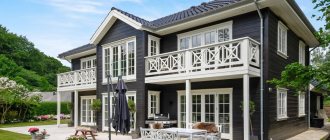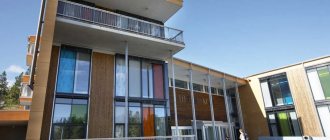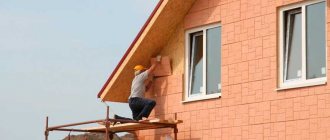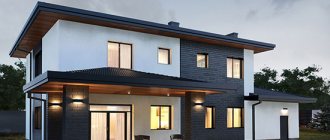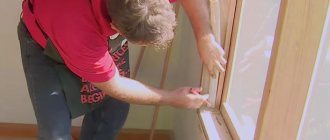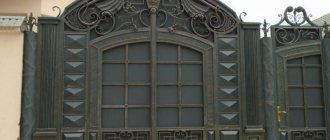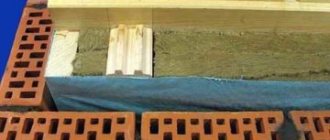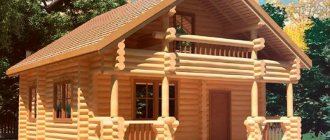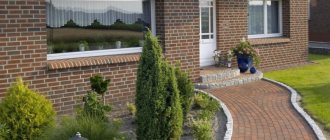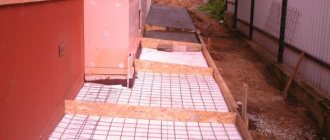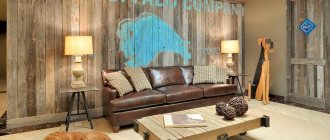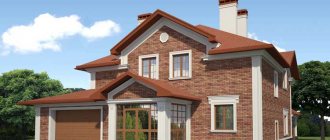One of the most ancient materials for facade finishing is wood. Now its use is especially relevant, since such cladding not only makes the appearance of the building attractive, but also provides reliable protection and additional thermal insulation of houses.
High-quality wood finishing of the facade will transform the appearance of a private home
Advantages and disadvantages of finishing the facade with wood
The use of wooden elements for cladding can solve many problems. Wooden facades have many advantages:
- absolute environmental friendliness and safety for human health;
- versatility, which makes it possible to combine brick, stone with wooden finishing elements;
- excellent camouflage for structural defects, as well as for a thick body-insulating layer;
- additional protection from adverse factors;
- the presence of natural ventilation, which means there is no need to install ventilation ducts;
- a wide variety of cladding options, which allows you to implement the most daring design ideas;
- presentable appearance - the façade of a house made from wood looks expensive and stylish.
There are fewer disadvantages of cladding the facade with wood, but they should also be taken into account. First of all, it is flammable, so it is necessary to provide additional coverage with special compounds. Wooden elements are prone to drying out, swelling, cracking and other damage, so it is important to strictly adhere to the rules of transportation, storage, installation and operation.
Wood-look facade panels
A wooden house is associated with warmth and comfort.
Despite the abundance of materials, wood is valued everywhere for its environmental friendliness. If a different material was chosen for construction, wood finishing will give the house the spirit of the estate. However, real wood also has disadvantages. It is susceptible to burning, can dry out, rot, and is difficult to process and expensive. It is much easier to give the exterior the desired look with the help of wood-look façade panels. They are more durable than natural materials and are moisture resistant. If you choose products from a trusted manufacturer, then in addition to the realistic finishing with boards or clapboards, you will be able to preserve the original appearance of the house for a period of 20 or even 50 years. Wooden panels for the facade have their own characteristics. On sale you can find siding with an imitation of the texture of oak and spruce boards, as well as pine logs. Color and size are also offered in a wide range of options.
Materials for wooden finishing of facade walls
Decorating a private house with wood will be of high quality and durable only if you select the right material and install it using high-quality consumables strictly according to technology. The most common types of wood include oak, beech, ash, pine, and cedar.
| Breed | External characteristics | Durability | Peculiarities |
| Oak | Characterized by a wide variety of colors. Shades can be either golden or dark brown. | The service life is about 100 years. | A hard and very durable wood. Under the influence of load it is capable of deformation, but after the cessation of the influence it restores its shape. |
| Beech | It has a beautiful pattern of heart-shaped and shiny lines. | With proper care it will last more than 50 years. | It has good flexibility. It is susceptible to moisture and rots if not properly stored and cared for. |
| Ash | Available in various textures and shades: light brown, pink, yellowish. | In terms of service life, it is comparable to oak, but it is recommended to renew it every 50 years. | Very durable and flexible. Has excellent resistance to physical impact. The cost of such material is quite high. |
| Pine | A variety of colors, distinct patterns. | It is short-lived and lasts 10-12 years. | It has a low price, but is less resistant to mechanical stress, but has a low level of thermal conductivity. It is resistant to rotting due to the presence of a large number of resins in the composition. |
| Cedar | It has a yellowish tint and is available in various colors. | Can last for more than 25 years with proper care. | Resistant to pests, has good thermal insulation properties, and is practically not susceptible to rotting and mold. |
Choosing wood for finishing
There is no unattractive wood – there is only the wrong choice and an incorrectly implemented artistic concept! The native birch is beautiful in its simplicity, and the exotic keruing tree, brought to us from India, also enchants with its unusual texture. There are no comrades for taste and color, as they say. Different textures, different physical, chemical and operational characteristics.
For exterior finishing, cladding materials made from both deciduous and coniferous trees are suitable, including pine, which is pleasant to our ears for its price. However, we have to admit: the more valuable the species, the better and better the finishing and the higher the durability of the protective and decorative finishing coating. Let's look at the most popular breeds in a little more detail.
Oak is the king of finishing materials, which simply has no equal for this purpose. There are about 200 varieties of oak in nature! And the wealth of colors? From red-brown to light yellow-pink. Time passes and the oak darkens, but, surprisingly, such changes in no way detract from the decorative effect of the oak finishing coating; on the contrary, it becomes even more prestigious, even more significant, even more expressive. Oak is a very durable and hard tree: oak cladding will last as long as the house itself will serve you. The disadvantages of oak wood include: a porous structure, with pronounced large vessels. This feature imposes particularly stringent requirements on the drying process. In addition, certain difficulties are associated with grinding. That is why you should be especially careful when purchasing oak finishing materials. It is best to buy and install oak finishing materials from trusted sellers.
Beech is a very recognizable finishing material with a light pink, fine texture formed by thin vessels. In many ways, the popularity of beech, which is very close to oak in terms of wood hardness, is explained by its more affordable price.
The homogeneous structure of wood gives finishing materials made from it a “calm”, warm and soft shade. Not inferior to oak in strength, beech is perfectly sanded and tinted in almost any color. But beech is also very demanding when it comes to drying: if not processed correctly during use, it can behave unpredictably - crack or become deformed.
Ash is another very promising wood species. The color range ranges from light pink... to dark brown. The texture of the pattern contains small vessels and a pronounced characteristic ornament on the cut.
In terms of strength, ash is superior to oak itself(!), it is flexible, ductile, and can be sanded perfectly. And what is very important is that ash does not crack even if the drying is not very good. Exterior finishing elements made of ash will allow the owner of the house not to worry about their safety, which cannot be said about elite oak.
Cherry is a tree recognizable by its noble, warm pink-brown, sometimes pink-grayish tint. Over time, cherry wood darkens.
Cherry is easy to work with and is much softer than oak.
Walnut is a very unique tree. The color and structure of its wood differ depending on where the tree grew - in America or Southern Europe, but the value of the wood does not decrease at all. Being a relatively hard tree, walnut is easy to process and is resistant to deformation and the formation of cracks during the drying process.
Maple is a beautiful and expensive tree, distinguished by its noble texture and a wide range of shades - from white to reddish.
Maple has very high strength, impact strength, and sands well. This is a tree that is practically free of flaws and can be used in any finishing work.
Larch is a truly Russian representative on the market of valuable wood species. It is rot-resistant, extremely durable wood with a distinct and recognizable texture. The color range ranges from reddish-yellow to dark brown.
The disadvantage of larch is its capriciousness in processing, due to which larch is often used not as a finishing material, but as a building material. But when creating terraces, this tree is almost irreplaceable.
Cedar is another native Russian (or rather Siberian) representative of the world of building and finishing materials, even more resistant to rotting than larch. Being qualitatively dried, this tree of noble dark brown or light yellow tones does not change its properties anymore.
The cost of a block house made of pine starts from 200 rubles. per sq. m., larch linings - from 130 rubles, larch planks - from 140 rubles. per sq. m. Imitation of larch timber will cost 145 rubles. per sq. m. In comparison, eurolining made from tropical valuable mahogany species will cost from 1,500 to 3,000 rubles per “square”.
You can also find on the market eurolining made from particularly valuable species, which were brought to us from afar. This type of exterior finishing is considered elite. It is chosen by those who are going to not only surprise, but shake their imagination!
An example is lining made from ormosia , a valuable tree growing in the Philippines and the islands of New Guinea. The tree is classified as an endangered species, and the popularity of products made from it is explained by its phenomenal resistance to rotting and the destructive factor of humidity. Ormozia products are supplied to Russia in limited quantities and for a specific customer. The cost per square meter of ormozia is not given.
There is another tree in Southeast Asia that has gained particular popularity among a narrow circle of connoisseurs of exotic wood - this is merbau .
The merbau cut is unique and, above all, its color range is unique, presented in the widest range - from soft yellow to deep dark, dotted with small light veins. The texture of such wood can be examined for hours, not to mention the finishing materials made of merbau, the appearance of which evokes admiration and unquestioning respect for the owner of the house - a connoisseur of exotic beauty with such a refined taste.
Merbau is not at all afraid of moisture, direct sunlight, or temperature fluctuations over a wide range.
To content >>>
Types of cladding
There are two main types of cladding: wet and hinged. The first is achieved through the use of plaster or other similar mixtures, the second option involves fastening using profiles, special fastening systems and other things. Select the required type depending on the selected finishing material.
Block house
Finishing the facade of a wooden house with a block house
External finishing of the facade of a house with the help of a block house allows you to give respectability. In appearance, this material is a log sawn in half. With such cladding on the outside, the house will look as if it was built from a log frame. The block house has a fairly high level of moisture absorption, so it is already pre-treated with special compounds that repel moisture. This option has its own installation features. The panels are connected to each other using a tongue-and-groove system. Exterior finishing of a block house can be done using:
- kleimers;
- self-tapping screws;
- nails
The first option is quite convenient and significantly speeds up the installation process. It is suitable for cases where the sheathing is located frequently. If self-tapping screws or nails are chosen as fastening elements, they must be treated with compounds that protect against corrosion.
Siding
Budget cladding of the facade with wood siding
Siding is an excellent option for cladding the facade with wood. A wooden board can be solid or glued together from several elements. Attaching siding is very simple, so you can handle this type of finishing yourself quickly and without problems. The boards are mounted overlapping on the vertical sheathing. An important advantage of siding is the ability to repair individual parts of it without violating the integrity of the entire façade finish.
Wooden shingles
Wooden classics - shingles on the facade
The installation feature of this option is overlapping installation. On the one hand, this is a plus, since it ensures natural drainage of precipitation, which significantly extends the life of the facade. On the other hand, it is very difficult to install it yourself. The shingles look like small plates of wood. A house lined with this material looks very stylish and impressive.
Thermowood
Installation of facade systems made of thermowood
Wood that has been subjected to heat treatment acquires high levels of strength and resistance to the influence of adverse external factors. It is these characteristics that have made thermowood so popular for façade cladding. When using such wood for cladding, it is not necessary to use additional antiseptics and moisture-repellent impregnations.
At the same time, thermowood has a number of significant advantages:
- increased level of strength and hardness;
- environmental safety and preservation of the healing properties of wood;
- resistance to fire, precipitation, mechanical stress;
- not susceptible to insects;
- preventing the formation of mold and mildew;
- bright, rich color that does not fade when exposed to ultraviolet light.
The use of wood that has undergone heat treatment when finishing the facade will create reliable, long-lasting protection for the house and give it an original look.
Eurolining
Finished façade covered with euro-lining.
The lining panels are attached to each other using a tongue-and-groove system. This greatly simplifies the installation process and makes the material especially popular. In turn, when choosing eurolining, you need to pay attention to the class. The material differs depending on the quality of processing and the presence of knots. Finishing the facade of a private house with wood will be reliable and beautiful if you use A or Extra class lining. To ensure the protection of the panels from the influence of aggressive factors, they should be pre-treated with antiseptics and opened with a moisture-repellent agent.
Eurolining is most often mounted on clamps, which are attached to the surface of the facade using self-tapping screws or galvanized nails. The fastening procedure is very simple, since the eurolining is quite light. This is also a plus for the structure itself, since it does not create additional load on the supporting structures.
HPL panels
Ventilated facade made of HPL panels
An innovative material for facade finishing, made by combining fiber and cellulose and then pressing them at high temperatures.
This technology makes it possible to produce panels that have the following advantages:
- high resistance to mechanical damage;
- resistance to precipitation and ultraviolet radiation;
- durability;
- unpretentiousness in care;
- light weight, which allows you to finish even large surfaces at high speed;
- no need for processing before and after installation.
A super durable and mega-attractive façade using HPL panels is guaranteed with the correct installation technology.
Ventilated facade
Wood-like ventilated
façade A suspended or ventilated facade allows you to ensure the safety of wood, which can accumulate moisture from the wall surface, as well as hide imperfections and unevenness.
Its design involves the construction of a frame made of metal profiles or wooden sheathing. It is on this that the thermal insulation layer is subsequently attached, and then the finishing. This design prevents moisture accumulation due to natural ventilation of the facade. As a result - the absence of fungus and mold.
Wall-mounted finishing
The construction of so-called ventilated facades is the best way to finish any walls of a building, regardless of the material from which the facade is made: wood, brick or stone. At the same time, such structures perform several functions:
- Strengthen the strength of the load-bearing wall of the building;
- Perform a high-quality decorative function;
- Create a heat-saving environment for the premises.
Installation of a ventilated facade
Brackets for the sheathing are mounted on the walls of the building, then the insulation is fixed. A sheathing made of a metal profile or timber is fixed to the fastening elements. Their thickness, in this case, determines the size of the system's air cushion. This is what ensures ventilation of the wooden facade. To ensure high-quality air movement during the finishing of private houses, it is recommended to leave additional eyelets at the top and bottom. A special membrane is attached to the prepared sheathing, which will protect the heat-insulating material from condensation forming on the surface of the facade.
When attaching the membrane, pay attention to the correct location of the roll. The absorbent side must be attached to the wall of the house. Incorrect installation will lead to destruction of the insulation layer and further repair of the entire system.
The wooden finishing material is attached to the sheathing using special fasteners, depending on the design of the particular product.
Types of wooden facade cladding material
Decorating the walls of a house with wood may seem quite expensive for some. The modern construction market offers a huge variety of wooden facade materials, which differ in cost, appearance, strength, thermal insulation, and performance characteristics. Before you decide, you should carefully study all the options and choose the most suitable one for the facade.
Imitation of timber
Cladding a house with imitation timber
A practical and inexpensive, compared to others, type of facade finishing. The panel fastening system is simple, which allows you to handle the installation yourself. In this case, the house will look as if it was built of wood. You can purchase imitation timber in various colors, so every lover of wood materials will be able to find the right one. This type of cladding is environmentally friendly and has a fairly long service life - about 30 years. It can be considered universal, since it can be mounted on various types of surfaces: wood, brick, concrete, foam block and others.
Lining
House facade made of clapboard
A special connection system eliminates the appearance of cracks and damage to the integrity of the facade. This material does an excellent job of heat and sound insulation and, in combination with insulation, will help significantly save on heating costs. Installing the lining is easy. The façade cladding should begin from the bottom up, with the spikes located in the upper part. To ensure that the appearance of the lining is pleasing for a long time and does not fade in the sun, it should be periodically treated with protective agents.
Block house
Finishing the facade of a wooden house with a block house
The facades of houses made of natural wood, finished using a block house, look as if they were built from rounded logs. In fact, one part of such panels is flat and has a tongue-and-groove system, thanks to which the individual elements are connected. This is a more expensive type of wooden material compared to the previous ones. But its strength and external properties are also an order of magnitude higher. With the help of a block house you can realize bold ideas and add attractiveness to even the most inconspicuous house.
Wood siding
An example of a façade covered with wooden siding.
A comfortable, cozy atmosphere inside the house and an attractive view from the outside - all this is achieved by cladding with wooden siding. The panels are mounted on the sheathing, which allows for ventilation and prevents the accumulation of moisture. Attaching siding is simple, but you should first calculate the required amount so that there are enough solid boards. Corner elements are cut using a hacksaw. When sheathing at an angle, leave a gap between the corner and main panels. Upon completion of installation, it is necessary to treat this gap with a special mastic.
Planken
Facade planken made of larch and pine
Wooden boards with a thickness of 10 to 30 mm, which are placed at an angle to the surface are called planken. Most often it is made from Siberian larch. This material has excellent resistance to external factors, as well as a low level of thermal conductivity. In addition, the price of this breed is affordable, so such facade cladding will be relatively inexpensive.
To install the plank, you should take into account the recommendations of specialists so that the result meets your expectations. You should leave a slight gap between the boards, as wet conditions can cause the wood to swell, causing it to swell. This is possible thanks to the rounded edges. There are no gaps in which additional moisture can accumulate.
General information
Among the main advantages of cladding the facade with wood, one can separately highlight its attractive appearance and environmental friendliness. On the other hand, wood is a problematic material, the use of which is directly associated with high susceptibility to combustion, biological damage and structural destruction due to high levels of humidity.
To minimize these risks, only the best, high quality wood should be purchased before use. Also, when choosing, take into account the type of wood, the presence of knots or other defects, the moisture content and the quality of processing. With the slightest damage to the structure, you may experience the development of mold/mildew in the future. For this reason, when purchasing, regardless of the declared quality of the product, conduct a thorough audit.
Boards
This is perhaps one of the most popular options. For this, it is recommended to use pine lumber, as well as spruce or other exotic species. As for the dimensions, the boards should be from 4 to 5 meters in length, 0.1-0.2 meters in width, and 0.2 to 0.35 meters in thickness. You can get acquainted with the standard option for finishing the facade with wood (boards) by looking at the photo.
Usually the process is not difficult and you just need to hammer the boards with nails on all sides of the fastening. But we advise you to pay attention to models that have tongue-and-groove locking joints or something like that. This is not only reliable, but also beneficial in terms of strengthening and sealing. But even in this case, you cannot do without securely fixing each element to the base.
The direction of the board also plays an important role. Both horizontal and vertical arrangement of elements are practiced, but which one is better? As practice shows, horizontal configurations look much better, but the option of placing boards vertically will be more durable. In this case, rainwater flows down, does not linger and does not destroy the structure of the tree on the sides and inside.
Lining
Interestingly, this material is very often confused with boards, block house and siding. But lining has many differences from the listed materials, among which I would like to note the following:
The plank format, namely the width is from 5 to 7 cm, and the thickness is only up to 20 cm.- There are grooves and perforations for locking connections. With this type of work on a wooden facade, factory processing is not optional, as it is with boards, but mandatory.
- If there is a special profile in the form of a deep tongue-and-groove joint, this is already a eurolining, which is manufactured according to Western standards.
- There is also an American lining, which has a beveled profile, which allows the builder to carry out overlap installation.
- Low humidity, from 10 to 15%. Even during the creation process, there is a mandatory procedure - drying, which increases the strength of the material and its structure.
- There are no knots, chips, “blue” or other types of damage.
Yes, we can say that lining is an aesthetically attractive and neat material, but it, in turn, is difficult to install for outdoor use.
Wood siding
This type of making a wooden facade with your own hands is popular with plastic and metal materials, but even lumber can be used for the base for siding.
At the same time, the main difference between siding and lining or boards is that not solid wood is used, but pressed wood - chip-wood cladding, which is made from fibers; they, in turn, are compressed under high pressure at a certain temperature. Why is this method good for finishing?
If you look at the photo, which shows the siding finish, you can understand that the decorative properties of the design are excellent, but this is not the only advantage. Thanks to dense pressing, the siding is durable and resistant (lasts up to 15 years). There are also panels that use a combination of composites and wood. Thanks to this connection, the material will even resist contact with moisture, but take into account the nuances of fire and environmental safety; if this is your first priority, then siding is not your option.
Combinations with different materials
If we talk about the combination of materials, then we can touch upon not only the cladding as such, but also the finishing of the façade design as a whole. Usually there are hybrid claddings that use stone and wood. Decorating with stone has many advantages, not only aesthetic, but also technical. This cladding is reliable in texture and texture, belongs to the traditional style, but it does not always need to be used for small houses.
Such a limitation is sometimes imposed due to the fact that the base of the walls is not reliable enough, and in some cases the stone visually reduces the building. But still, the use of natural heavy stone and wood is justified and popular.
With this design of the facade with wood and stone, fragmentary cladding with boards, clapboard and or siding is required on the main surfaces. You can use the “zoning” technique, and then parts of different functionality will be finished with different materials. One option is to decorate the facade with wood, and you can partially decorate or strengthen the basement, porch, bay window areas, corners or balconies.
Fastening wooden elements on the facade
Cladding the facade of a house with wood can be done in different ways. The method is selected depending on the type of cladding used, the characteristics of the surface and the personal preferences of the owner. There are open and closed methods.
| Closed | Open |
| Most often used. This method will require special fasteners that are mounted on the inside of the wood paneling. The most common are clamps, keys and snakes. They have already been pre-treated with special compounds, which eliminates the occurrence of corrosion. | Hardware such as nails, screws and self-tapping screws are used. They are attached from the outside into holes previously prepared in the wood and sealed with putty. This will prevent further cracking of the wood. The putty can be replaced with a plug made of a similar material. |
Installation features
Installation of the panels does not require any special training from the contractor and can be done year-round. KEDRAL siding can be easily attached to either a galvanized or steel subsystem in a ventilated façade structure, to wooden blocks, or directly to the walls themselves.
To install the cladding, you can use the adhesive method or lathing, which acts as a frame. If the working surface is flat, panels with a wood pattern are attached with glue. This solution is primarily recommended for plastic boards that are light in weight.
If you have chosen panels with a wood pattern made from lumber, then you will need to build a wooden frame on which the products are mounted using screws and staples.
The cladding is distinguished by a large selection of decorative solutions. Along with smooth wood-look panels, manufacturers offer options with a relief surface and 3D pattern, which will allow you to choose an option for any interior.
House in Country style, facing the facade with wood-effect siding panels or fiber cement façade boards
The panels are perfectly fixed on any surface: brick, wood, aerated concrete blocks, sip panels, etc. When installing facade panels on wooden structures, it is recommended to pre-treat the latter with a fire retardant and antiseptic. There are two ways to attach panels:
- visible (on self-tapping screws);
- hidden (on clasps).
You can read more about wood-effect panels on our website in the section all about CEDAR boards made of fiber cement, facade panels for cladding houses.
Main types of varnish for coating wooden facades
Treatment of the facade with varnish is mandatory when working with wooden cladding, since without a protective coating the wood can become deformed and lose its quality characteristics. The modern selection of varnishes allows you to choose the appropriate option for any type of cladding.
Oil
Applying a coat of oil to wood siding
The most affordable finishing option for wood. For outdoor work, you should choose a greasy product. Only it is capable of adequately protecting a wooden facade from atmospheric influences. When oil varnish is applied to wood, a film is formed that prevents moisture accumulation and fading from ultraviolet radiation. The only drawback of this option is the long drying period. – from 12 hours to 3 days. For this reason, the time for work must be selected when it is warm and dry.
Alkyd
High-gloss urethane-alkyd varnish for wood
Compositions containing alkyd resin have good protective properties against any type of impact. Increasing resistance to mechanical influence, creating a protective barrier against rodents, increasing resistance to precipitation and ultraviolet radiation are the main advantages of alkyd varnish. However, such products emit an unpleasant odor when applied. The varnish dries within a day. Processing must be carried out carefully, the layer should not be too thick, since with too much varnish the coating may wrinkle.
Water based
Water-based varnish for wood
Water-soluble products are safe because they do not emit harmful substances or unpleasant odors. The protective characteristics of water-based varnishes are an order of magnitude lower than those of other products. For this reason, updating the wood coating must be done regularly. The coating dries in 24 hours, while it will take about 2 weeks for the final protective film to form.
Yacht and polyurethane varnishes are also used for finishing, but they are used much less frequently. Regardless of the type of product, you should strictly follow the manufacturer's instructions. But there are also general recommendations that must be followed:
- paint wood in dry and warm weather;
- the wood must be dry;
- The composition should be applied to a cleaned and sanded surface;
- priming, treatment with antiprene and antiseptic will help protect the surface and ensure adhesion of varnish and wood.
It is necessary to apply the varnish evenly over the entire surface, so it is more rational to use a spray bottle, and for hard-to-reach places use a brush.
Why tree
Modern man is constantly in a “concrete jungle” that is unable to create a feeling of comfort and homely warmth. Only in a house made of wood can you feel comfortable and calm.
There are many reasons why wood cladding is gaining popularity today:
- Wood can be combined with any type of finishing materials. For this reason, designers often resort to full wood cladding. It can be successfully combined with stone or brick.
- Using wood for façade cladding is a practical solution. This allows you to hide various shortcomings of load-bearing structures.
- Insulation material can be installed under the cladding.
- Wooden cladding will provide excellent protection for walls from adverse weather conditions.
To decorate a house with wood, you must first select the type of wood.
Caring for wood floors
The main enemies of wooden cladding are moisture and accompanying microorganisms (fungi, mold, etc.). In order to protect the surface, special impregnations should be used. The façade must be treated with them regularly. The period of reapplication depends on the type of cladding, but on average, experts advise updating the protection once every 5-7 years. You can also paint the surface to update the color and provide protection, but wood is so self-sufficient that you can do without it.
With proper installation and proper care, a wooden facade will delight its owner for many years. This eco-friendly type of finishing can create a unique and original exterior.
